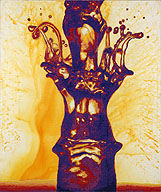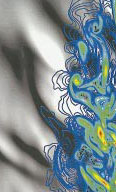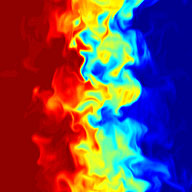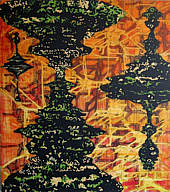Simulations - the science behind the images see also:
|
|||
|
This series is based on images that were not seen directly, but which required some intermediary apparatus to make them visible. |
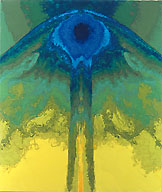 Jonathan Feldschuh, SN1a.4.06, acrylic on canvas over panel, 57" x 48", 2004 |
||
|
Analog Interpolation / Scale Many of the source images used for the paintings are quite low-resolution. This is sometimes due to the size/bandwidth limitations of web-published images, but is also an intrinsic quality of numerical simulations, where computing resources scale exponentially with resolution. |
 full-size still; Marietta, Model of a SNIa blast interacting with a main sequence star I |
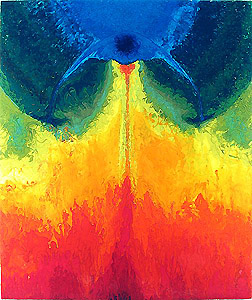 Jonathan Feldschuh, SN1a.1.01, acrylic on canvas over panel, 57" x 48", 2004 |
|
The limitation of information in the source is a fascinating issue for me as a painter, as I am forced to use the material properties of paint to simulate and interpolate (i.e. fabricate) the missing detail. Paint is wonderfully analog.
|
 detail of above |
 detail of above |
|
|
In his book Chromophobia, David Batchelor discusses the bias against color that he sees in many aspects of Western culture. Color is suspect in science precisely for the reason that it is endlessly fascinating to a painter - because it carries a limitless range of associations and references, cultural and art-historical. Scientists love color for its ability to represent information, but are wary of any use of it that might be "subjective" |
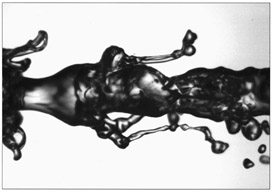 |
Jonathan Feldschuh, Drop Formation #1, acrylic on canvas over panel, 57" x 48", 2004 |
|
| 2D - 3D - 4D - 5D - 6D A color movie is a 4D representation of colored 2D slice evolving in time. Actual information is generally at least 6-dimensional (3D spatial grid, in time, in color, selected from range of attributes (e.g. temperature, vorticity, etc.) Visualization is an essential technique to make sense of the vast arrays of data produced. |

|
||
| Flow Fluid movement shapes almost everything that does not have a rigid structure (and much of what does) Painting these images reproduces in a way the same forces of fluid dynamics that are in play. The randomness and accidental quality of the interactions of the liquid paint has the effect of simultaneously degrading and enhancing the original images. |

details of Jonathan Feldschuh, Mach Wave #1, acrylic on canvas over panel, 57" x 48", 2005 |

|
|
| Scale The scale of the images ranges from the cosmic (Cold, Dark) to the stellar (SN1a) to the everyday to the microscopic (DNS#1) to the molecular (DNA): |
|||
|
Cold Dark Matter Galaxy formation, Thomas Quinn (UW) N-Body/SPH et. al
|
DNS Chemical mixing, Stephen de Bruyn Kops - Amherst
|
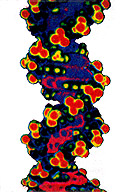 DNA space-filling model |
|
Elegance:Some paintings are based on visualizations of theories of quantum gravity -- essentially, these are representation of the symmetry structures that might underlie everything.
|
Simulation of Lorentzian 2d Quantum Gravity
|
Jonathan Feldschuh, Quantum Foam #1. acrylic on canvas over panel, 36" x 32", 2001 |
|
| - Jonathan Feldschuh, July 2005 | |||
| Look at more
statements |
|||
